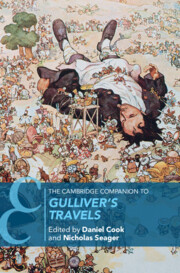Book contents
- The Cambridge Companion to Gulliver’s Travels
- The Cambridge Companion to Gulliver’s Travels
- Copyright page
- Contents
- Figures
- Notes on Contributors
- Abbreviations
- Note on the Text
- Chronology
- Introduction
- Part I Contexts
- Part II Genres
- Part III Reading Gulliver’s Travels
- Chapter 9 Advertisements and Authorship
- Chapter 10 A Voyage to Lilliput
- Chapter 11 A Voyage to Brobdingnag
- Chapter 12 A Voyage to Laputa, Balnibarbi, Luggnagg, &c.
- Chapter 13 A Voyage to the Land of the Houyhnhnms
- Part IV Afterlives
- Further Reading
- Index
- Cambridge Companions to Literature
Chapter 13 - A Voyage to the Land of the Houyhnhnms
from Part III - Reading Gulliver’s Travels
Published online by Cambridge University Press: 05 October 2023
- The Cambridge Companion to Gulliver’s Travels
- The Cambridge Companion to Gulliver’s Travels
- Copyright page
- Contents
- Figures
- Notes on Contributors
- Abbreviations
- Note on the Text
- Chronology
- Introduction
- Part I Contexts
- Part II Genres
- Part III Reading Gulliver’s Travels
- Chapter 9 Advertisements and Authorship
- Chapter 10 A Voyage to Lilliput
- Chapter 11 A Voyage to Brobdingnag
- Chapter 12 A Voyage to Laputa, Balnibarbi, Luggnagg, &c.
- Chapter 13 A Voyage to the Land of the Houyhnhnms
- Part IV Afterlives
- Further Reading
- Index
- Cambridge Companions to Literature
Summary
When a female Yahoo makes sexual advances to Gulliver in Part IV of the Travels, he is forced to acknowledge that he ‘was a real Yahoo’. This recognition has disturbed readers as much as it appalled Gulliver. Is Swift a misanthropist? Or does he recommend a middle ground between Yahoo and Houyhnhnm? So many people found the last part of Swift’s Travels both unfathomable and distasteful that it was frequently omitted from nineteenth- and early twentieth-century editions, especially those intended for children. Part III suffered the same fate. Neither book seems to fit with Swift’s imaginatively appealing tales of little and large people. Yet it is likely that he conceived all four parts to work as a whole. This chapter argues that rather than being the spot of solid ground onto which the shipwrecked reader can crawl and from there look back over the rest of the text to find it resolves itself into an order that points at one clear meaning, Part IV leaves many readers baffled and discomforted – and that is the point. While animal fables generally end with an explanatory ‘moral’, Swift obliges readers to work through the complexities and conundrums of his text.
- Type
- Chapter
- Information
- The Cambridge Companion to Gulliver's Travels , pp. 164 - 176Publisher: Cambridge University PressPrint publication year: 2023

